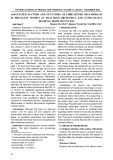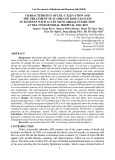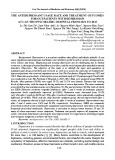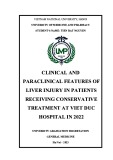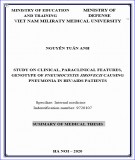1
INTRODUCTION
In general, cancer including Lymphoid Proliferations are a “hot” healthy problem of the Vietnamese people today. Lymphoide proliferations consists of 2 groups: lymphoma and lymphoid hyperplasia. According to the study of Cancer Hospital, lymphoma incidence is ranked 5th, ranked 6th in the causes of death due to cancer.
Ocular Adnexal Lymphoma in primary accounting for 42% of the types of ocular adnexal tumors, the blindness ratio 2 4%, the death rate after 5 years is about 25%. In contrast, only 5% to 8% of patients with nonHodgkin lymphoma whole body and then (secondary tumors). Lymphoid spread to ocular adnexal hyperplasia sometimes also known as reactive lymphohyperplasia or atypical lymphoid hyperplasia or pseudo lymphoma, accounting for about 20% of the cases lymphoid proliferative disorders. This lesion morphology diagnosis through surgery histopathology navigation.
Lymphoid proliferations whether at any location on the body and cause damage to the aesthetic, functional, and even life threat. Adnexal occular is common position of non Hodgkin lymphoma, after the lymph nodes of the head and neck. When nodes are not big, good health condition also, the patients will choice the eye examination firstly. History taking, examination, additional tests then biopsy or tumor remove have extremely important implications for the determined diagnosis, histopathological classification, orientation and selection methods treatment, monitoring and prognosis of patients.
2
To contribute to the overall understanding of adnexal lymphoid proliferations in terms of: clinical and paraclinical features, the treatments outcomes, complications... the research group conducted the thesis
“Ocular Adnexal Lymphoid Proliferations: clinical and
paraclinical features, treatment outcomes” The thesis has the following objectives : 1. Describe the clinical and paraclinical characteristics of
adnexal ocular lymphoid proliferations.
2. Reviews the results of treatment of adnexal ocular lymphoid
proliferations.
OVERVIEW
1.1. OCULAR ADNEXA: being parts support, protect, protect the eyeball (ocular adnexa).Thus, the extra eyeballs will include:
Eyelids Conjunctiva, related glands Main lacrimal gland, lacrimal pathway Orbit: extraocular muscles, fat, blood vessels and nerves
1.2. Ocular Adnexal Lymphoid Proliferations
When lymphocytes are present and proliferate in places where they normally do not have a condition called lymphoid hyperplasia. Lymphocyte proliferative disease (lymphoproliferative disordersLD) in the eye will manifest in the ocular and ocular. However, presentation intraocular is very rare.
Ocular Adnexal Lymphoid Proliferations is " epidemic outbreak " in Asian countries like Japan, Korea, Taiwan, the annual average incidence increased from 1.5% to 2.5%. In the US there are 45,000
3
new cases developing each year, the annual average incidence increased about 6.2%. Over 1,269 autopsies of patients who died of lymphoma 1.3% seen in Ocular Adnexal Lymphoid Proliferations. This rate in the patient group of nonHodgkin's lymphoma with the remaining 5% extranodal lymphoma is 8%. Ocular Adnexal Lymphoma causes 10% orbital tumor in adults and 1.5% of conjunctival neoplasm. The most recent hypothesis that lymphomas arise from a process of normal response of the lymphocytes with infection or inflammation or lymphogenesis factor mutant. There are two pathophysiological mechanisms have been demonstrated. A lymphoma is associated with chronic inflammation, infection, immunosuppression process or autoimmune disease. The secondary hypothesis is normal tissue develop into lymphoma as a chronic inflammatory response to H. pylori due in MALT lymphoma or u extranodal gastric gland lymphoma.
Ocular Adnexal Lymphoid Proliferation (conjunctiva lacrimal gland orbit)
Adnexal Ocular Lymphoma (Malignant, non Hodgkin)
Adnexal Ocular Lymphoma (Hodgkin lymphoma, almost nerver seen in clinical)
Lymphoid hyperplasia (benign hyperplasia, reactive hyperplasia, pseudo lymphoma)
Ocular Adnexal Lymphoid Proliferation Classification
1.3. CLINICAL SIGNS
4
1.3.1. Taking history and investagtion: should pay particular attention to history of:
Organ transplantation, use of antirejection medication Immune disorders: Sjogren's syndrome, systemic lupus
erythematosus, rheumatoid arthritis Immunodeficiency: AIDS Peptic ulcer: H. pylori infection Infections, viral infections: Chlamydia psittaci, HPV, adeno
virus
These diseases are believed to have been laid the foundation for immune response disorders make up effect "carcinogene", affecting the differentiation of immune cells including lymphocytes, causing genetic abnormalities and chromosomes of lymphocytes line. On AIDS patients, the ration between men and women who suffering lymphoma is 7.38: 1
1.3.2. Clinical symptoms, diagnosis General situation: patients may have mild weight loss (<10%), night sweats, fever. However, many cases are asymptomatic. Only when patients were in advanced stages, stage lymph node lesions of patients will have aggressive expression in the spine, urinary system, gastrointestinal, head and neck lymph nodes, eyes... At this stage, people depression is very fast. On AIDS patients adnexal ocular lymphoid proliferations often occur in the final stages should be accompanied by cachexia, multiple organ infections...
Ophthalmic findings
5
Clinical manifestations of adnexal ocular limphoid proliferations very diverse. The symptoms are atypical and not serious:
Pain little or no pain Diplopia, slightly blurred vision Eyelids swelling, ptosis slightly Proptosis mild and moderate, proptosis grow slowly The expression of tumor compression: choroidal folds, papilledema, decreased vision, limited eye movement associated with diplopia, conjunctival congestion...
The expression of tumor invasion: from orbital spread eyelids, from orbit spread conjunctiva, infiltration from orbit to both eyelids and conjunctiva.
1.4. PARACLINICAL PRESENTATIONS 1.4.1. Ultrasound B: is the least valuable in the diagnostic imaging tool. Mass effects if detective often discreet, involving the lacrimal gland, extraocular muscles, optic nerve, without calcification. However in the case of intraocular lymphoma, primary or associated with brain damage ultrasound B provide some valuable indicators: thickens uvea, vitreous cavity shrunk, scleral thickness and wider than normal, with no calcification 1.4.2. CT Scanner: orbital bone intact, no erosion, without larger or thickeness. Lymphoma often locates in extraconic space, deflect eyeball. The characteristic Xray: usually have a relatively high density, light contrast staining, homogeneous density, linked closely to the soft tissues, create shadows in orbit like “mud plash” 1.4.3. MRI : the lesions has lower signal than orbital fat, signal density as equal as the brain in T, medium gadolinium staining.
6
MRI with injection Gallium Citrate (Ga 67) also allows pointout lymphoid tumors recur after treatment or not. In some cases, the tumors are detected by MRI meanwhile CT give normal results.
1.4.4. Anatomohistopathology of adnexal ocular lymphoid
proliferations
To diagnose and classify lymphomas need to follow the steps
sequentially:
Based on cell morphology: large cell tumor cells or small. Classification according to cell line: require specific standards
of immunophenotype: B cell or T cell T infiltration
Immune markers, cytology: very useful to distinguish the case
is not clear.
With patients suffering adnexal ocular lymphomas, an anatomohistopathology laboratory should provide information of tumors as follows:
§ Evaluation of cell morphology § Research on immuno phenotype § Data on molecular genetics (if necessary) § Cell genetics (not routine) § Analysis of gene expression (not routine)
1.5. ADNEXAL OCULAR LYMPHOID PROLIFERATION
TREATMENT
Treatment method depends on the histologic morphology of tumor and stage of disease. So far, there are still some debates over whether adnexal ocular lymphoid proliferations has actually been cured ?
1.5.1. Chemotherapy
7
So far CHOP formula was equally effective with the new formula
as ProMACEC, mBACOD, MACOPB, so still the most popular.
CHOP formula has low toxicity on hematopoietic system, rarely neutropenia with grade 3 and grade 4, hemoglobin decreased slightly, no thrombocytopenia. Hepatic enzyme increased slightly, mainly at the 1st level. No having kidney damage, after stopping therapy indicators are back to normal.
Some characteristics of the immune phenotype and histology are seen as predictors of potential outcomes in patients with adnexal ocular lymphomas. Cases of CD5 and CD43 positives only present in a small percentage of patients with adnexal ocular lymphomas but related to the bad clinical presentation and adverse consequences. The adnexal ocular lymphomas not indicated systemic chemotherapy unless otherwise histopathological type lymphomas are diffuse large Bcell (DLBCL). 1.5.2. Radiotherapy
Radiotherapy is the method most commonly used to treat localized lesions due adnexal ocular lymphomas is found in many patients. Some studies using the WHO classification and assessment radiotherapy dose response showed 81% of cases EMZL / MALT stop development at the original location in 5 years with a lower dose of 36 Gy but was higher than 30 Gy
1.5.3. Immunotherapy
The recent study of cases and case series also showed broad applicability of inhibitor preparations, immunomodulator such as cyclosporine, interferon alpha
1.5.4. Treatment with antilymphocyte antibodies
8
Lymphocyte antibodies are the latest treatments for lymphoma. The use of antibodies to CD20 (rituximab) to destroy B cells based on induced impacts on the apoptosis, antibody mediated destruction and cytotoxic or cellmediated toxicity up with antibodies.
Radioimmunotherapy is a new application of immunotherapy. In which people linked CD20 antibody with Iodine 131 or Ytrium 90, makes chemicals go hit diseased tissue, destroy the target cells more accurately.
1.5.5. No treatment
Horning SJ with evidence of 23% of patients with lymphoma manifestations, of low malignant, self regresses stated views should track which no treatment for patients with lymphoma presentations in conjunctiva.
1.5.6. Surgical treatment
Once the disease has not yet manifested whole body, only the eye abnormalities, patients would came to eye specialist to diagnose and treat. Now, ophthalmologists are natural "pioneers" to diagnosis and classification of anatomohistopathology, initial treatment, combination treatment and longterm monitoring of patients. For those patients who have been diagnosed with a cancer specialist through marrow and lymph node biopsies, the ophthalmologist will see patients at a later stage, when the disease spread to the eye or eye complications caused by radiotherapy. With both primary adnexal ocular lymphoma or secondary the opthalmologist must solve immediately the complications of tumor, can cope with some special disease of this patient group: intraocular lymphomas, pseudo postscleritis, pseudo uveitis.
9
Surgical treatment is almost mandatory to obtain definitive diagnosis by taking test tissue anatomy histology have the effect of removing the tumor from the body. Method tumor surgery nearly 50 years without a breakthrough, only small improvements [7].
In summary of Rootman on 122 patients with adnexal ocular lymphoma, 80% is MALT type. In which the proportion of patients no further progress after the first treatment and 05 years disease free survival on the corresponding 71% and 98%, 61% and 90% at 10 year. However B cells diffuse lymphoma, follicular lymphoma mantle cell lymphoma, immune blastoma have a bad prognosis: rapid progression and early recurrence, high mortality rate. Other studies of Coupland, Rosado showed no progression rate and high rate of free survival after 5 years, on average 90%.
10
OBJECTIVE, DESIGN, METHODS AND STUDY MATIERIALS
2.1. OBJECTS, PLACES AND STUDY TIME
The patients with adnexal ocular lymphoid proliferations examinate and surgery at the Central Eye Hospital from Dec/2010 to Dec/2012.
2.1.1. Criteria for selecting patients
were confirmed the diagnosis of adnexal ocular lymphoid
proliferations with pathology results
firstly treated with good behavious and well cooperations volunteer to be involve in research
Intervention
Postintervention group
Preintervention group
Comparison
2.2. METHODS: observational study was descriptive and clinical intervention
ỡ ẫ 2.2.1. C m u
1
2/
n = Z2 (cid:0) (cid:0)
)p1(p (cid:0) 2 d /2) = 1.96
Z(1(cid:0)
reliability level is 95% (cid:0) p is the rate of misdiagnosis, estimated p = 5%
11
d is the absolute precision (9% 21%) = 13%
n = 64 patients
2.2.2. Patient selection method
Patients with adnexal ocular lymphoid proliferations meet the
criteria of sample, without exclusions, is indicated surgery:
incisional biopsy, excisional biopsy or excision.
In case of difficult circumstances, it need to be tested by
immunohistochemistry
Patients were evaluated clinical characteristics before and after
surgery, assess treatment outcomes and factors related...
Patients were followedup for 2 years postoperation (24 months)
2.2.3. Research facilities
Medical documents Tools for medical examination: Snellen eye chart letters,
tonometer Maclakov, ophthalmometer of Hertel, anesthetic topical
solutions and mydriasis agents, slitlamp for eye examination,
fundus eye ophthalmoscopy, digital cameras, fundus eye
photography, Humphrey visual field analyser
Surgical microscope magnification from 0.4 to 1.0
Forehead wearing surgical loupe X4 magnification.
The orbital surgical instruments, oculofacial bone cutter and
driller.
CTScanner with injectable contrast agents
Examination of anatomicalhistopathological routine and
histobiochemistry staining
EpiInfo software Stata 6.4 and 8.0 to load and process data.
12
Follow up notes, invitations letter for reexaminations.
13
FINDINGS
From Dec/2010 to Dec/2012 we had the surgery and followup for 64 patients (79 eyes). The patients were followed up for 24 months (2 years). At study endpoint of Oct/2014 general information and data about the patient summarized as follows:
3.1. PATIENT CHARACTERISTICS OF RESEARCH GROUP
3.1.1. Characteristics of patients by age and gender
Chart 3.1: The distribution of patients by age
Our research shows that the average age of patients was 56.6 years old, the youngest is 24 years old, the oldest is 88 years old. Men with 42 patients (65.6%), women have 22 patients (34.4%), there was no significant difference in gender statistics. This result is consistent with studies of Shield CL et al with an average age of 66 years (median 69, range 2 93 years old). Male patients accounted for 61% and 39% is female.
14
Chart 3.2: Distribution of patients by gender
Table 3.1: Medical history
Medical history
Gastroduodenal ulcers ENT diseases High blood pressure Traumatic brain injury Diabetes type I No illnesses Total n 1 1 1 1 1 59 64 % 1.56 1.56 1.56 1.56 1.56 92 100%
Our study has only patients with single patient suspected pathology can cause lymphoid proliferative diseases. So not much orientation about causeseffects. Medical history notes Table 3.2: The time has tumor in the eye
Time < 12 months 13 24 months >24 months Unknown n 40 12 12 0 % 62.5 18.75 18.75 0
15
100 Total
64 The majority of patients presenting within one year after the appearance of the first upset of 62.5%. For many reasons, such as people's habits, quality of primary eye care is low, there are still 12 patients (18.75%) up to 12 months of fist visiting, also with that ratio visit later 2 years of illness. 3.1.4. Clinical style
In 64 studied patients have all manifested only in the eyes, general condition is very good, so are the primary adnexal ocular lymphoid proliferations.
Chart 3.4: Eye of involvement 3.2. CLINICAL CHARACTERISTICS OF ADNEXAL OCULAR LYMPHOID PROLIFERATIONS 3.2.1. Reasons for visit
16
Chart 3.3: The reasons to take the examinations of study patients Common signs are consistent eyelid oedema, tumoral palpation 84%, then the pain17%, double vision or blurred vision3%. Other authors have also shared with us a statement that the adnexal acular lymphoid proliferations is very little effect on vision.
3.2.3. Clinical exams
3.2.3.1. The functional explorations
Table 3.3: Vision acuity (post correction Snellen chart)
Vision Acuity
20/20 to 20/40 20/50 to 20/200 20/200 to 20/400 <20/400
n 40 19 12 8 79 Total % 51 24 15 10 100
Adnexal ocular lymphoid proliferations not usually cause vision loss unless tumors put pressure on the optic nerve causing papilledema prolonged then atrophic papilledema.
Table 3.4: Hospital entering intra ocular pressure
17
Hospital entering n % intra ocular pressure
< 24 mmHg 2430 mmHg >30 mmHg
Total 71 7 1 79 89 9 2 100
High intraocular pressure is due to solid tumors, extensive infiltration in the upper eyelids, lacrimal gland, fornix conjunctiva and cause compression on the eyeball in many directions.
18
3.2.3.2. Physical symptoms
Superior 76%
Extra conial space 90%
Both 5%
Medial 13%
Lateral 44%
Intra conial Space 5%
Inferior 16%
Chart 4.3: Comparison of clinical manifestations
Chart 4.1: Lesions involving cornial spaces and frontal plane
Superior
In the frontal plane, the tumor in the upper and outer is high percentage of 76% and 44%. Up to 92% of tumors occur in touchable parts of adnexal ocular include lids, conjunctiva, lacrimal gland and lacrimal pathway, preseptum orbit While the tumors in the posterior bulbar and intraconic space is only 5%.
19
Chart 3.5: Anatomical location of adnexal acular lymphoid proliferations
Undefinition
The tumor can also infiltrate and integrate into superior rectus muscle 60% and inferior rectus muscle 49%. Conjunctiva and lacrimal gland tumors can also invade. In which lacrimal gland is damaged pretty much as 63%. Effusion sinus reactions we encountered 6 patients, but no patients had brain damage. 3.3. RADIOLOGIC FEATURES
Chart 3.6: Radiologic characteristics
20
In our study, adnexal ocular proliferations has a number of radiologic characteristics as follows:
Infiltrate diffuse into the orbital tissue, uneven density Wrapped around the eyeball with can be seen on CT film like molding.
There is 52% of tumor which boundary is not clear and diffuse, 48% has remarkable boundaries with round shape or long tail. When compared with Forell. W we can see tumors is well demarcated, round or long vertical axis (tail) seems not the features of adnexal ocular lymphoid proliferation. Tumors infuse strongly the constrat agent (94%). Bone almost no damage (96%), only 4% have bone erosion or bone extended.
64 Specimons of adnexal acular lymphoid peolifeations
HE Stasining First analusis Classi fication following WF
Reanalysis for 32 cases unknown Perform Immunohistobiochemistry reaction if necessary WHO classification
Working Formulation classification (WF): 8 cases of hyperplasia 24 cases of lymphoma 32 cases unknown
3.4. ANATOMOHISTOPATHOLOGIC FEATURES
21
22
Table 3.10: Summary of anatomohistopathological results of study patients
Anatomohistopathological type n %
Hyperplasia 11 17
WF1 12 18
WF2 3 5
WF3 2 3
WF4 2 3 Working Formulation classification of 24 cases non Hodgkin lymphomas WF5 5 6
86 Extranodal marginal lymphoma 25
3 11 Mantle lymphoma
B large cell diffuse lymphoma 1 3 WHO classification of 29 cases non Hodgkin lymphomas
Demerci. H on 160 patients was statistic: Reactive lymphoid hyperplasia: 14 (9%) Atypical lymphoid hyperplasia: 21 (13%) Malignant Lymphoma: 125 (78%) Our study, well concordance with author above on concluded that lymphoid hyperplasia has a smaller proportion of 20%, if separable the reactive lymphoid hyperplasia or atypical lymphoid hyperplasia will be lower than 10%.
3.6. TREATMENT Table 3.15: Treated options and outcomes
Results Regression No change Recurrence Treament
Sugery 64 0 5
Surgery+ Chemotherapy 5 0 0
Surgery+ 0 0 0
23
Chemotherapy+Radiotherapy
3.6.1. Surgery Table 3.12: Surgical types
Surgical types
Incisional biopsy Excisional biopsy Excision
Total n 1 3 60 64 eyes % 1.5 4.5 93 100
Table 3.13: Surgical methods
Methods n %
53 83 Approaches the orbit through the skin and tumor excision.
the orbit through the 9 14 Approaches conjunctiva and tumor excision.
2 3 Orbitotectomy, approaches the orbit and tumor excision.
Total 64 eyes 100
3.7 OPHTHALMIC TREATMENT All 64 study patients after surgery continued medical therapy supplemented as summarized below: Table 3.17: Postopeartion treatment
Patient number % Postopeartion treatment n=64
64 100 Maxitrol ophthalmic solution and ointment
24
62 96 Caricine 250mg or Orokin 250 mg, oral
Medrol 16 mg, oral 63 98
Vision Acuity
Intraocular pressure
Diplopia
Increase 2/79 Corrected 72/79 No improvement 0
Reduce 1/79 Semicorrected 0 Improvement 1
Stable 76/79 Uncorrected 1/79 Disappearance 1
Ophthalmic additional treatment to reduce swelling quickly, aesthetic and eye lid aperture improving day by day, wound and scar are beautiful or acceptable. The types of surgical support as ptosis surgery, strabismus surgery, fistula surgery... not conducted on any patient. 3.8. TREATMENT OUTCOMES 3.8.1 Functional results Table 3.18. Results of visual fonction
3.8.2. Aesthetic Outcomes
63/64 patients have satisfied the aesthetic and eye function. One patient because only minimal intervention by biopsy should have not achieved aesthetic effect after surgery. 3.8.3. Systemic results
Activities Level
Overall evaluation of the systemic patient's condition in the end point of our study: 60 patients (93%) live free of tumors. Two patients are quite weak but still selfservice, the main cause is due to age rather than disease. Two patients died during the followup period. Table 3.18: Evaluation daily activities (recommended by WHO) % 93 1.5 0: Activate normally, no limitation 1: Restrict the activities but walk, do light n 60 1
25
housework normally. 2: Still walk but can not do light housework 3: Immobile at bed 1 0 1.5 0
3.9. FOLLOW UP, RECURRENCE AND MORTALITY
ứ ử
Table 3.19: Sequelaes Percentage n 1.56 1 Cách th c x trí Medical treatment
1 1.56 Medical treatment
Lesions Optic atrophy Intraocular high pressure Ptosis 1 1.56 Frontal muscle suspension
Two patients died after surgery 13 and 15 months. The patients have recurrent, have to do bone marrow biopsy include: 2 patients with tumor recurrence insitu, 5 patients with tumor recurrence and spread early combination with cervical nodes. However LDH enzym was not quantitative. Two patients marrow puncture safety results, tumor recurrence but in the same location, had continued treatment in ophthalmology environment for 20 days of Orokin or Caricine antibiotics, repeating the formula of Medrol and the tumor remissioned. Five patients with recurrent tumors early with cervical nodes to be transferred to cancer hospital for chemotherapy.
26
Chart 3.8: follow up, recurrence and mortality
CONCLUSIONS
On 79 eyes of 64 patients, conducted in a specialized hospital, in a short time, our study hopes to contribute more knowledge about a tumoral disease quite common tin ophthalmology and the 6th most common cancer in Vietnam with the following information:
1. The clinical, paraclinical features of adnexal ocular lymphoid
proliferations
Clinical features The medical history is not effective to orientate diagnostic
and treatment.
The average age of patients was 56.6, men dominated (65.6%). Visual acuity was good in majority of patients on admission 76%, with 7 patients had glaucoma due to tumor compression.
27
We found that lesions in the left eye more than the right eye wiht the corresponding rate was 42.2% and 34.4%. Percentage of damage in both eyes of 15 patients (23.4%).
The most common reasons caused the patients enter the hospital is palpable tumors at the rate of 81%, then eye lids edema percentage over 73%. Proptosis are not very often 44%, tumors often do not cause pain83%.
The tumor usually locate in the orbit 90%, 73% tumors seen in the superior lateral orbit, usual found at extraconic space. Lacrimal gland63%.
The basic clinical symptoms: mild and moderate proptosis accounted for 44%, 81% palpable tumors with the following characteristics: hard density (71%), difficult to determine the boundaries (51%).
Paraclinical traits: Xray image typically mixedlow and high density signals66%, tends to spread and difficult to determine the boundaries of 89%, strong staining absorbed 94% and no orbital bone damage 96%.
Adnexal ocular lymphoid proliferations include adnexal ocular nonHodgkin's lymphoma corresponding 87% and the remaining are benign hyperplasia (17%), only be assigned by analyzing anatomo histopathology results. In 24 patients were classified according to the Working Formulation(WF) with 17 patients with a low malignancy (70%) and the rest is the average malignant 7 patients (30%).
All the primary tumor is essentially lymphoid tumors of B cell, 40% belong to the low level and the average malignant classified by
28
WHO Extranodal Marginal Zone Lymphoma(EMZL) majority 86%. Severe disease, poor prognosis patients met on 4/64 patients (3 patients with MANTLE lymphoma11% and 1 patient (3%) diffuse large B cells lymphoma)
The clinical presentation, morphology histopathology, immunohistochemistry, molecular biology as the basis for classification suptype of adnexal ocular lymphoid proliferations. The markers as CD20 immunohistochemistry (+), CD79, cyclinD1, CD 43 (), MIB1 and p53 are important to predict treatment outcome and disease stage.
3. Overview of the treatment results of adnexal ocular lymphoid
proliferations
All the patients underwent tumor resection with high success rates> 90% for the following purposes: to confirm the diagnosis, treatment orientation and prognosis, largely removing the tumor or the entire, improved aesthetics and visual function.
Results of treatment: increase and maintain patient acuity 95%, lowering the intraocular pressure of the usual 98% rate, aesthetic satisfaction95%, comfortable life and pretty normal 93%.
After 24 months of followup sequelae encountered are: nerve injury did not recover 1 patients, ptosis 1 patient, double vision due to injured extraocular muscles1 patient. There are 5 patients with tumor recurrence in invasive cervical lymphadenopathy was treated by chemotherapy CHOP formula, still live healthy until the end of the study. Two patients died, one because of age and one do tumors spread at ENT and brain.
29

